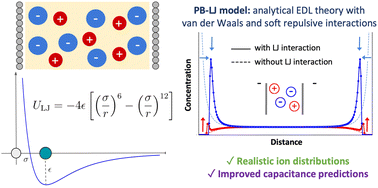Incorporating ion-specific van der Waals and soft repulsive interactions in the Poisson–Boltzmann theory of electrical double layers†
Abstract
Electrical double layers (EDLs) arise when an electrolyte is in contact with a charged surface, and are encountered in several application areas including batteries, supercapacitors, electrocatalytic reactors, and colloids. Over the last century, the development of Poisson–Boltzmann (PB) models and their modified versions have provided significant physical insight into the structure and dynamics of the EDL. Incorporation of physics such as finite-ion-size effects, dielectric decrement, and ion–ion correlations has made such models increasingly accurate when compared to more computationally expensive approaches such as molecular simulations and classical density functional theory. However, a prominent knowledge gap has been the exclusion of van der Waals (vdW) and soft repulsive interactions in modified PB models. Although short-ranged as compared to electrostatic interactions, we show here that vdW and soft repulsive interactions can play an important role in determining the structure of the EDL via the formation of a Stern layer and in modulating the differential capacitance of an electrode in an electrolyte. To this end, we incorporate ion–ion and wall–ion vdW attraction and soft repulsion via a 12-6 Lennard-Jones (LJ) potential, resulting in a modified PB–LJ approach. The wall–ion LJ interactions were found to have a significant effect on the electrical potential and concentration profiles, especially close to the wall. However, ion–ion LJ interactions do not affect the EDL structure at low bulk ion concentrations (<1 M). We also derive dimensionless numbers to quantify the impact of ion–ion and wall–ion LJ interactions on the EDL. Furthermore, in the pursuit of capturing ion-specific effects, we apply our model by considering various ions such as Na, K+, Mg2+, Cl−, and SO42−. We observe how varying parameters such as the electrolyte concentration and electrode potential affect the structure of the EDL due to the competition between ion-specific LJ and electrostatic interactions. Lastly, we show that the inclusion of vdW and soft repulsion interactions, as well as hydration effects, leads to a better qualitative agreement of the PB models with experimental double-layer differential capacitance data. Overall, the modified PB–LJ approach presented herein will lead to more accurate theoretical descriptions of EDLs in various application areas.



 Please wait while we load your content...
Please wait while we load your content...